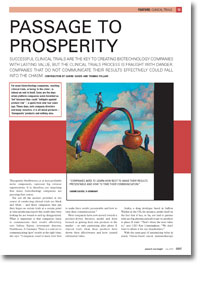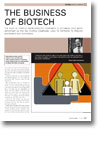
Passage to prosperity
- Article 2 of 7
- iSight, July 2003
Successful clinical trials are the key to creating biotechnology companies with lasting value, but the clinical trials process is fraught with danger. Companies that do not communicate their results effectively could fall into the chasm.
Page 1 | Page 2 | Page 3 | Page 4 | All 4 Pages
PAINFUL LESSONS
US company Biomira is only too aware of the consequences of communication. The interim analysis of the phase III trial of its Theratope cancer vaccine in September 2002 had repercussions in the market that could possibly have been avoided.
Biomira publicly placed high expectations on the results of this interim analysis – including filing a shelf registration in May 2002 at well above the company’s value in anticipation of the results. According to the press, the purpose of the interim analysis was to accelerate registration on the back of extremely positive results. While the company’s stock price rose significantly in the lead up to the interim results, it dropped equally sharply when they did not deliver the desired outcome. As BioCentury put it, given that the jury was still out on the efficacy of Theratope, the company’s bumpy ride might well have been the price for being too anxious.
Of course, it may not be up to the company whether or not it releases results, or how any communication is phrased. Corporate partners provide funding, expertise and, most importantly, credibility to biotechnology companies, whose products they in-license or jointly develop. Many biotechnology companies, therefore, carry out clinical trials in association with these partners. However, when it comes to releasing the results of individual studies, views on appropriate communication – or whether there should be any communication at all – vary widely.
For a large pharma partner, there is clearly much less at stake, so how it words the communication and when it releases any news is, in many cases, less important. Also, the pharma partner and the biotechnology company may have completely different interpretations of the results.
“One word of a pharma is worth more than 1000 words of the biotech company,” warns Michele Garufi, CEO of French biotechnology company NicOx. In February, news was released regarding a phase II study of one of NicOx’s compounds, which was jointly conducted with a large pharma company. The market reaction to the news was a steep fall in NicOx’s stock price, and the stock only recovered a little when NicOx released a clarifying statement three weeks later. Although the overall news was not actually that bad for a phase II study, the way it had been presented adversely affected public opinion and that has been hard to repair.
KEY STATISTICS
In a number of business areas, such as consumer goods, companies tend to proclaim themselves as market leaders by defining their market segment sufficiently narrowly. There is a similar tendency in biotechnology. As a number of analysts have commented, companies tend to slice and dice their data any way they can to show that their drugs work.
However, showing why a drug has worked better in a certain group of patients can pave the way to a better understanding of the drug and further successful trials. And while saying that a drug has worked in a sub-group means, reading between the lines, that it has failed in the overall set-up, the news itself might not be too bad at all, depending on the expectations that were attached to it beforehand.
When results are good for a sub-group only, how the markets respond is far from predictable, even if the results are presented properly. Compounding the problems of communication, sometimes even political correctness can come into play. Californian company VaxGen found itself confronted with this conundrum earlier this year when it was trying to explain to the public that, while the overall outcome of its phase II study for a HIV drug was disappointing, there were some encouraging results in two sub-groups – Afro Americans and Asians.
As BioWorld put it, “Mainstream media scrambled to get a handle on the story, as reporters tried not to embarrass themselves in efforts to be both accurate and politically correct.” The stock market’s reaction was unambiguous though, justified or not – the company’s share price dropped 47.3% on the day of the announcement.
While it is difficult to control the specialist press and the financial community, it can be even harder trying to control the non-specialist press. But this is essential. When dealing with life-threatening diseases, such as AIDS or cancer, too much is at stake when the cure is promised for tomorrow. Patients’ hopes are raised prematurely and in vain. The company loses credibility in the specialist community, and it might find itself being pulled into a compassionate need programme.
Page 1 | Page 2 | Page 3 | Page 4 | All 4 Pages


